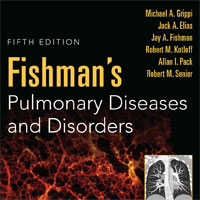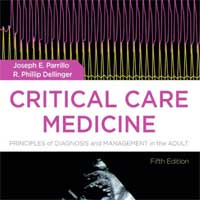Tag: ARDS
14-Day Occurrence of Hypoxia, ICU Admission, and Death Among Patients with COVID-19
Uncertainty surrounding COVID-19 regarding rapid progression to acute respiratory distress syndrome (ARDS) and unusual clinical characteristics make discharge from a monitored setting challenging. Model derivation and... read more
COVID-19 and ARDS: The Baby Lung Size Matters
COVID-19 in its initial manifestations has strikingly peculiar characteristics (e.g., hypoxemia with vasocentric injury and high gas lung volume), is so evident that atypical ARDS should not be a matter of further discussion.... read more
What’s new about pulmonary hyperinflation in mechanically ventilated critical patients
Pulmonary hyperinflation is the increase in the relaxation volume of the respiratory system at the end of a tidal expiration (end-expiratory volume). This can occur due to a number of factors, acting alone or in combination,... read more
Fishman’s Pulmonary Diseases and Disorders
Since 1980, Fishman's Pulmonary Diseases and Disorders has delivered unparalleled coverage of pulmonary medicine and the underlying basic and applied science upon which clinical practice is based. The Fifth Edition, with... read more

Myorelaxants in ARDS patients
Neuromuscular blocking agents (NMBAs) inhibit patient-initiated active breath and the risk of high tidal volumes and consequent high transpulmonary pressure swings, and minimize patient/ ventilator asynchrony in acute respiratory... read more
Emerging pharmacological therapies for ARDS: COVID-19 and beyond
ARDS, first described in 1967, is the commonest form of acute severe hypoxemic respiratory failure. Despite considerable advances in our knowledge regarding the pathophysiology of ARDS, insights into the biologic mechanisms... read more
Lung Histopathology in COVID-19 as Compared to SARS and H1N1 Influenza
Diffuse alveolar damage (DAD) was reported in 88% of patients with COVID-19. This is similar to both H1N1 (90%) and SARS (98%). Pulmonary microthrombi was reported in 57% of patients with COVID-19. This was similar to... read more
Some Signs of Recovery From Severe COVID-19 Lung Damage
In two early studies, researchers said some patients showed signs of healing just weeks after leaving the hospital. Lingering shortness of breath and diminished stamina have dogged many COVID patients whose lungs were... read more
Synthesis and Systematic Review of Reported Neonatal COVID-19 Infections
A number of severe acute respiratory syndrome coronavirus-2 (SARS-CoV-2) infections have been reported in neonates. Here, we aim to clarify the transmission route, clinical features and outcomes of these infections. We present... read more
High Plasma Levels Linked to Severe ARDS in Children with Respiratory Failure
Elevated surfactant protein D levels are associated with severe acute respiratory distress syndrome and poor outcomes in children with acute respiratory failure, according to results published in Chest. Elevated surfactant... read more
Factors Associated to ICU Mortality in Critically Ill Patients Infected with COVID-19 in Spain
Older COVID-19 patients with higher APACHE II scores on admission, those who developed AKI grades II or III and/or septic shock during ICU stay had an increased risk-of-death. ICU mortality was 31%. A total of 663 patients... read more
Extracorporeal Cytokine Adsorption as an Alternative to Pharmacological Inhibition of IL-6 in COVID-19
With great interest we read the article by Convertino et al. discussing potential treatment targets for pharmacological immunomodulation in coronavirus disease 2019 (COVID-19) with acute respiratory distress syndrome (ARDS).... read more
Critical Care Medicine: Principles of Diagnosis and Management in the Adult
Now completely revised to bring you up to date with the latest advances in the field, Critical Care Medicine: Principles of Diagnosis and Management in the Adult, 5th Edition, delivers expert, practical guidance on virtually... read more

Endothelial Dysfunction Role During COVID-19
Emerging data suggest a crucial role of endothelial dysfunction during SARS-CoV-2 infection, as a direct target of the virus and inflammatory cytokines as well as the main actor in orchestrating a pro-inflammatory and pro-coagulant... read more
Gastrointestinal Complications in Critically Ill Patients With and Without COVID-19
This study found a higher rate of gastrointestinal complications, including mesenteric ischemia, in critically ill patients with COVID-19 compared with propensity score–matched patients without COVID-19, suggesting a distinct... read more
Fibrin-derived Peptide as Salvage Treatment in Critically Ill Patients with COVID-19-associated ARDS
After SARS-CoV-2 first occurred in China in December of 2019, it set out to become a global pandemic. Critically ill patients constitute about 2–9% of all infected patients and progress from pneumonia and hypoxemia to multi-organ... read more
How Severe COVID-19 Infection is Changing ARDS Management
The COVID-19 pandemic has provided many intensivists (and some non-intensivists) several years' worth of severe ARDS management experience over the course of just a few months. While the challenges have, in places, been extreme,... read more
Coagulopathy of COVID-19
Severe acute respiratory syndrome coronavirus 2/coronavirus disease 2019 frequently induces hypercoagulability with both microangiopathy and local thrombus formation, and a systemic coagulation defect that leads to large... read more
ECMO During the Coronavirus Disease 2019 Pandemic
In the midst of the 2009 influenza A H1N1 pandemic, clinicians turned to extracorporeal membrane oxygenation (ECMO) as a strategy to save lives. Based on the H1N1 experience, and the ECMO to Rescue Lung Injury in Severe... read more
Asthma Among Hospitalized Patients with COVID-19 and Related Outcomes
Among hospitalized patients 65 years or younger with severe COVID-19, asthma diagnosis was not associated with worse outcomes, regardless of age, obesity, or other high-risk comorbidities. Future population-based studies... read more
Awake Prone Positioning for COVID-19 Hypoxemic Respiratory Failure
Infection with SARS-CoV-2 can result in Coronavirus Disease–19 (COVID-19). While the majority of patients are asymptomatic or have mild disease, approximately 14% develop more severe disease including hypoxemic respiratory... read more
Plasma Exchange in Critically Ill COVID-19 Patients
The spectrum of coronavirus disease 2019 (COVID-19) ranges from asymptomatic infection to respiratory failure and death of patients. Severely affected patients may develop a cytokine storm-like clinical syndrome with multi-organ... read more









